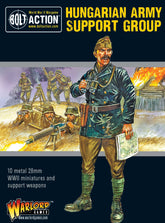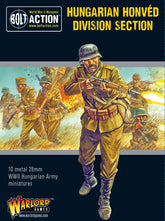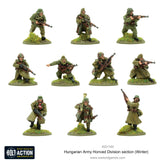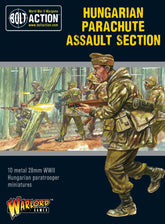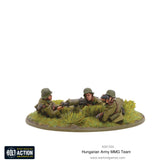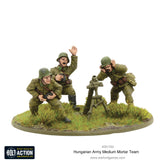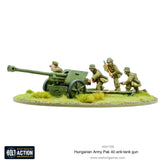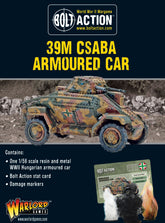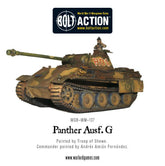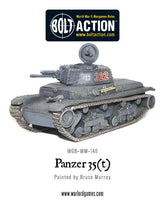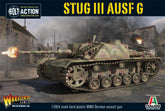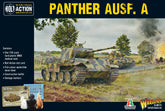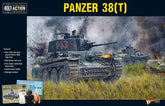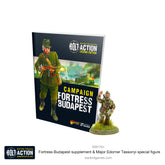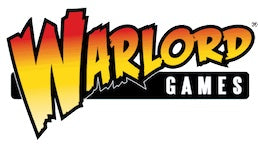Additional Axis Armies
Filter by Axis Army : Finland; Romania; Bulgaria; Hungary;
The Axis powers, also known as "Rome–Berlin–Tokyo Axis", grew from a series of treaties through the 1930s. Initially between Germany and Italy. A declaration by Benito Mussolini late in 1936 stated that all other European countries would from then on rotate on the Rome–Berlin axis, thus creating the term "Axis".
Japan joined the pact with the signing of an anti-communist treaty and by 1939 the "Rome–Berlin Axis" had become a military alliance. During World War II, the Axis presided over territories that occupied large parts of Europe, North Africa, and East Asia.
Finland ▼
Finland’s role during World War II was both unique and remarkable. The Finns achieved spectacular military successes against the Soviet Union despite being heavily outnumbered and lacking much in the way of modern equipment including tanks and anti-tank weapons.
Finland’s war against the Soviets was in many respects a separate affair, and the Finns themselves certainly tend to consider it as such. Once the Soviets joined the Allied camp following Hitler’s invasion of Russia, Finland had no option left but to seek aid from Germany, so although never officially part of the tripartite pact of Germany, Italy and Japan, Finland was regarded as an Axis power during the post-war settlement.
Romania ▼
The Romanian oilfields were of great importance to Nazi Germany, and critical to the operation of the Axis war machine. Preserving access to this resource was of prime importance. In June of 1940, the Soviet Union issued an ultimatum to the Romanian government that was to result in Romania surrendering the territories of Bessarabia, Northern Bukovina, and Hertza to the Soviets. This Soviet threat to the oil fields convinced Hitler that, one way or the other, Romania must be secured.
When Hitler finally decided to go to war with Russia, Romania was key to his plans. A large number of Romanian troops were involved in Operation Barbarossa and the Romanian Army loyally supported the Axis cause as they pushed through the Crimea as far as Stalingrad. Stalingrad was a major defeat for the Romanians, and a general retreat followed through the Caucasus.
Bulgaria ▼
Bulgaria intended to maintain its neutrality at the start of hostilities. In 1941, German troops moved through Bulgaria to reinforce the Italians fighting in Greece, and Bulgaria found itself drawn into the conflict. Bulgaria joined the Tripartite Pact and became one of the Axis powers, but played little part in the wider war.
Bulgarian troops did take part in the fighting in Greece, where the country’s leaders took the opportunity to expand its borders to the south and west. These territorial ambitions were local affairs, a matter of dispute since World War I, and Bulgaria’s chief war aims were to annexe what it saw as natural Bulgarian territory within its neighbour’s borders.
Hungary ▼
The Hungarian forces were put under the overall command of the German Wehrmacht and used in Operation Barbarossa, pushing as far as Stalingrad. The Hungarian army swelled from a peacetime strength of 80,000 to over 200,000. The force’s effectiveness was dampened by ineffective equipment and limited training as well as by the harsh weather.
The well-supplied but quickly trained Hungarian Second Army accompanied the German Second Army Group South in the invasion of southern Russia, finally arriving at the battle of Stalingrad. The Hungarians were dealt a huge defeat in the face of a Russian pincer attack near Svoboda on the Don River. This effectively destroyed the Hungarian Second Army as a fighting force.
After the battle of Stalingrad and the crushing defeat of the Second Hungarian Army, most Hungarian forces were switched to defence as anti-Axis sentiment grew at home. The prime minister saw the writing on the wall and started secret negotiations with the Allies. Though the Allies kept negotiations secret from the Soviets, the Germans discovered them, resulting in a German invasion of Hungary in the spring of 1944.
- 10
- 15
- 20
- 25
- 30
- 50
- Featured
- Best selling
- Alphabetically, A-Z
- Alphabetically, Z-A
- Price, low to high
- Price, high to low
- Date, old to new
- Date, new to old
Sort by:
- Featured
- Best selling
- Alphabetically, A-Z
- Alphabetically, Z-A
- Price, low to high
- Price, high to low
- Date, old to new
- Date, new to old
-
Hungarian Starter ForceThe Royal Hungarian Army Hungary raised and deployed two Armoured Field Divisions, one mechanised Cavalry Division, and eight Assault gun Battalions. The Carpathian Army Group was sent as the initial contribution to the German’s Operation Barbarossa. This unit contained the most battle-ready forces the...
- £103.00
- £103.00
- Unit price
- / per
-
Hungarian Army support groupAvailable in this neat box set, the Hungarian Army Support Group - grab yourself the new Hungarian HQ, Medium Machine Gun and Medium Mortar! Hungarian Army HQ Since 1872, the Ludovica Military Academy had been turning out competent and efficient officers and graduated the...
- £29.50
- £29.50
- Unit price
- / per
-
Hungarian Army HQSince 1872, the Ludovica Military Academy had been turning out competent and efficient officers and graduated the majority of officers for the Hungarian Army. A core of competent and educated officers struggled to handle the large expansion of the Hungarian Army to meet the...
- £9.00
- £9.00
- Unit price
- / per
-
Hungarian Army Honved Division sectionAlthough the majority of infantry forces fielded by the Royal Hungarian Army in 1944–45 were not combat hardened, there were some experienced units after 3 years of fighting on the Eastern Front. Infantry Divisions of the Hungarian First Army had recently fought in the...
- £26.50
- £26.50
- Unit price
- / per
-
Hungarian Army Honved Division section (winter)Although the majority of infantry forces fielded by the Royal Hungarian Army in 1944–45 were not combat hardened, there were some experienced units after 3 years of fighting on the Eastern Front. Infantry Divisions of the Hungarian First Army had recently fought in the...
- £26.50
- £26.50
- Unit price
- / per
-
Hungarian Parachute Assault sectionThe 1st Hungarian Parachute Battalion was formed in 1940 with transportation provided by the national airline Mágyar Légiforgalmi R.t. They saw their first combat experience against Yugoslavia in 1941 where they captured the Franz Josef Canal after some initial mishaps. The paratroopers did not...
- £26.50
- £26.50
- Unit price
- / per
-
Hungarian Army MMG teamThe Schwarzlose 7/31M machine gun was used extensively in World War I and put to use right away in the new conflict. Models supplied unassembled and unpainted
- £11.50
- £11.50
- Unit price
- / per
-
Hungarian Army medium mortar teamLike virtually all nations, the Hungarians adopted a medium mortar based on the French Brandt 81.4mm. The 36/39M was common throughout the Hungarian Defence Force and employed modern shaped charges to good effect. Models supplied unassembled and unpainted
- £11.50
- £11.50
- Unit price
- / per
-
Hungarian Army Pak 40 anti-tank gunWebstore Exclusive! This artillery piece is supplied with a laser-cut oval MDF base (120mm x 92mm) - only available through this webstore. You can now base your complete gun and crew together, making attractive mini-dioramas! The 7.5 cm PaK 40 (7.5 cm Panzerabwehrkanone 40)...
- £24.00
- £24.00
- Unit price
- / per
-
Fiat-Ansaldo CV33 tankettePack contains 1 metal and resin vehicle. Note: Models supplied unassembled and unpainted
- £16.50
- £16.50
- Unit price
- / per
-
39M Csaba armoured carNamed after a famous son of Attila, king of the Huns, the Csaba 39M was produced in Hungary based on designs by Nicholas Straussler, a Hungarian designer living and working in Great Britain between the wars. Its principal service was 1939–44 and 101 were...
- £26.50
- £26.50
- Unit price
- / per
-
41M Turán II PlatoonThe 40M Turán I was based on Skoda T-21 tank prototypes taken over by the Germans following the annexation of Czechoslovakia. The tank featured the Hungarian 40mm A17 anti-tank gun and 50mm of frontal armour. Although comparable to many early war tanks, the Turan...
- £89.00
- £89.00
- Unit price
- / per
-
Panther Ausf GThe Panther was the best all-round German tank of the war and although conceived as a medium tank, at 45 tons and with frontal armour over 100mm thick, it could easily be rated more highly. The Panther's thick, sloping front armour was copied from...
- £35.50
- £35.50
- Unit price
- / per
-
Panzer 35(t)Originally produced as a light cavalry tank for the Czech Army and also supplied to Afghanistan, Romania and Bulgari, the Wermacht used 218 captured Czechoslovakian from March 1939 onwards. It saw plenty of use in the German Army being used in the Invasion of...
- £27.50
- £27.50
- Unit price
- / per
-
Panzer IV Ausf. F1/G/H medium tank (plastic)Whilst the propaganda headlines may well have gone to the big cats such as the Panther and the Tiger, the Panzer IV was the backbone of German armoured capability throughout the war. You can choose to build your Panzer IV as one of three...
- £22.00
- £22.00
- Unit price
- / per
-
Stug III ausf G or StuH-42 plastic box setThe Sturmgeschütz (StuG) III was a well-armed and armoured vehicle based on the tried and tested Pz.Kpfw III chassis. Manned by the artillery originally, as it was considered a mobile howitzer, it went through many variants during WWII, and indeed was one of the...
- £25.00
- £25.00
- Unit price
- / per
-
Panther Ausf AThe Panther was the best all-round German tank of the war and although conceived as a medium tank, at 45 tons and with frontal armour over 100mm thick and a high velocity KwK 42 L70 gun, it was more than a match for any...
- £25.00
- £25.00
- Unit price
- / per
-
Panzer 38(t)Most commonly known as the Panzer 38(t), this light tank was originally a Czech design – the LT vz. 38 – which fell under the Third Reich's control when Germany occupied Czechoslovakia in 1938. The 't' in its designation relates to the German for...
- £22.00
- £22.00
- Unit price
- / per
-
Campaign Fortress BudapestThroughout the autumn of 1944, the Axis forces in the Carpathian Basin were fighting for their very existence. Campaign: Fortress Budapest will inspire and guide you through the entirety of this particular conflict and on to many more victories with your Bolt Action forces!...
- £25.00
- £25.00
- Unit price
- / per
-
Digital Fortress Budapest PDFThroughout the autumn of 1944, the Axis forces in the Carpathian Basin were fighting for their very existence. Campaign: Fortress Budapest will inspire and guide you through the entirety of this particular conflict and on to many more victories with your Bolt Action forces!...
- £10.00
£20.00- £10.00
- Unit price
- / per










